Plant of the Month: March 2023
|
| Tobacco |
Nicotiana L.
|
SOLANACEÆ ; Nightshade Family
|
| Genus Nicotiana is world famous as the source of smoking tobacco. More than one species is smoked, though the main commercial one these days is Nicotiana Tabacum. In this brief article I share with you a few interesting facts. Entire books about tobacco exist. Here is a mere scant introduction to the topic. |
| In the wild, Nicotiana species grow in America, the S Pacific, Australia, and SW Africa. Beyond their native lands, some species are cultivated globally where climates allow. There are two main motives to grow tobacco: 1) to obtain smoking material; 2) to enjoy the plants as ornamentals. |
| The genus was named in 1753 for Jean Nicot de Villemain (1530 - 1600), who introduced tobacco seeds to France in 1560. |
| The 89 Nicotiana species are annual or short-lived perennial plants, or spindly shrubs to 20 feet tall. The leaves are usually sticky-hairy; sometimes smelly. Varied species and most hybrids are valued as ornamentals for their lovely, sometimes sweet-scented flowers --some colored lime green. The stems can be stout, the leaves bold sized, 2 feet long or more. A few species and hybrids are grown rarely as houseplants or in cool greenhouses. |
| Nicotiana supplies the widely used narcotic tobacco, that has nicotine and 20+ other pyridine alkaloids causing cancer; millions of people die each year. Nonetheless, there is reported edibility of some species. Also, valid medicinal application including anti-Alzheimer's. Nicotine is an agonist to the nicotinic Acetylcholine Receptors (nAChRs) targeted by the covid spike protein. That is why smokers were less hurt by covid, and why some doctors such as Bryan Ardis suggest wearing pieces (say 2 mg. size) of transdermal nicotine patches as covid preventative measures. |
| Nicotiana Tabacum L. has been called Earth’s most widely cultivated non-food crop. BUT, nicotinanamide derived therefrom: an essential compound for human life, is employed to enrich rice, flour and milk; to maintain color and flavor of ham and sausage. And it is possible to extract an edible protein, an odorless, tasteless powder, that is added to cereal grains, vegetables, and soft drinks; and can be whipped like egg whites, liquified, or gelled; can take on the flavor and texture of a variety of foods. Tobacco seeds yield an oil used after refining for edible purposes; the seeds are nicotine free. The sweet nectar has little nicotine. Moreover, some people around the world eat tobacco leaves as a vegetable. |
| Yet, despite what I just reported, nicotine in quantity causes vomiting, diarrhoea, a slow pulse, collapse and respiratory failure. Deaths have occured from eating tobacco leaves as boiled vegetable. The precise details of the plant variety, its age, the amount ingested, the part ingested, the pH, and so on, affect its narcotic and toxic properties. Leaf tobacco, as smoked in a pipe by native Americans, was neither addictive nor cancer-causing. But modern processed tobacco used in manufactured cigarettes, is dangerous. That is why cigarette packages contain warning labels. Incidentally, nicotine is not limited to the Nicotiana genus. |
| Nicotiana alata Lk. & Otto is called Flowering, Sweet, Sweet-scented, Ornamental, or Jasmine Tobacco. Native to S Brazil, N Argentina, Uruguay, and Paraguay. By far the most common ornamental species. To 4 feet tall. Leaves viscid, to 16 inches long. In its typical state its flowers measure 2 to 4 inches long, are greenish-white, night fragrant, closing during the day, and are moth-pollinated. But most plants sold now are its modern cultivars or hybrids that are more compact, with flowers of diverse colors and less or no scent. Some of these are even used as short-lived houseplants, perfect in summer window boxes. |
| Nicotiana sylvestris Speg. is called Woodland Tobacco. Native to Bolivia and NW Argentina, it is one of the ancestral parents of Nicotiana Tabacum. It has been cultivated in the Northern hemisphere since the 1870s and is naturalized weedily in some shady Seattle gardens, coming up wild even if unirrigated. It has lovely, scented white flowers as my 4 photos below show. Herbarium specimens were collected in November 2007 by Peter Zika and I, from one garden. It is in others, also. Luxuriant, it can easily reach 5 feet in height, even surpass 6 feet. Its appeal is both bold foliage of leaves to 2 feet long, and its lovely purest white, fragrant blossoms. |
I could supply details about other Nicotiana species, and do, in my unfinished edible houseplants book. But the above is all I can squeeze in this article, which is being posted late because I am so busy.
Back |
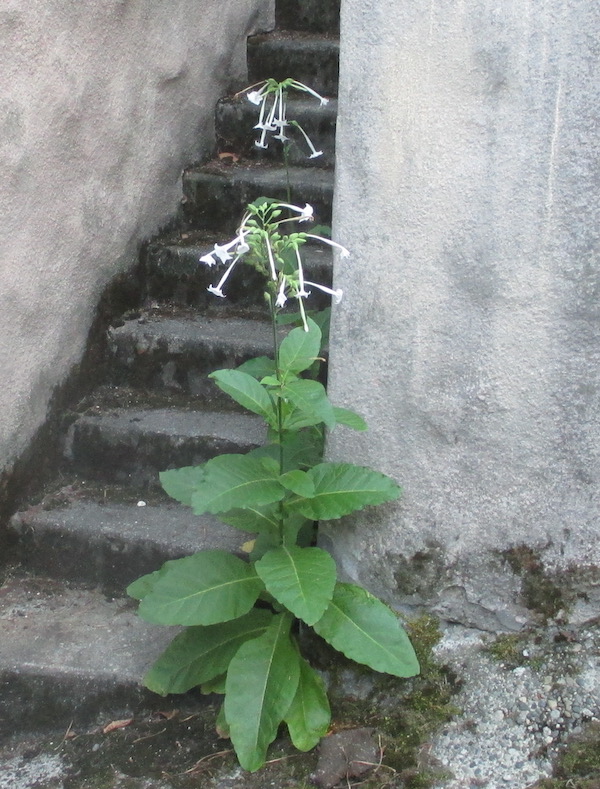
Nicotiana sylvestris ; photo by ALJ
|
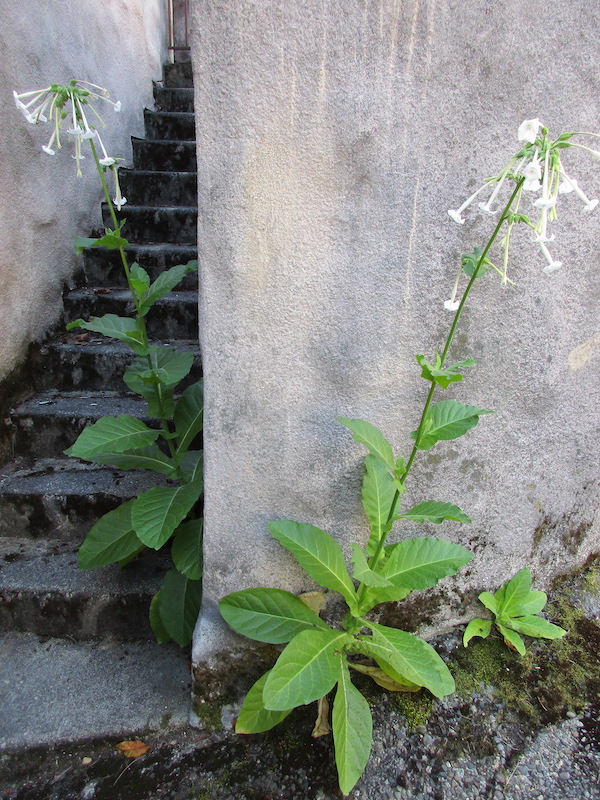
Nicotiana sylvestris ; photo by ALJ
|
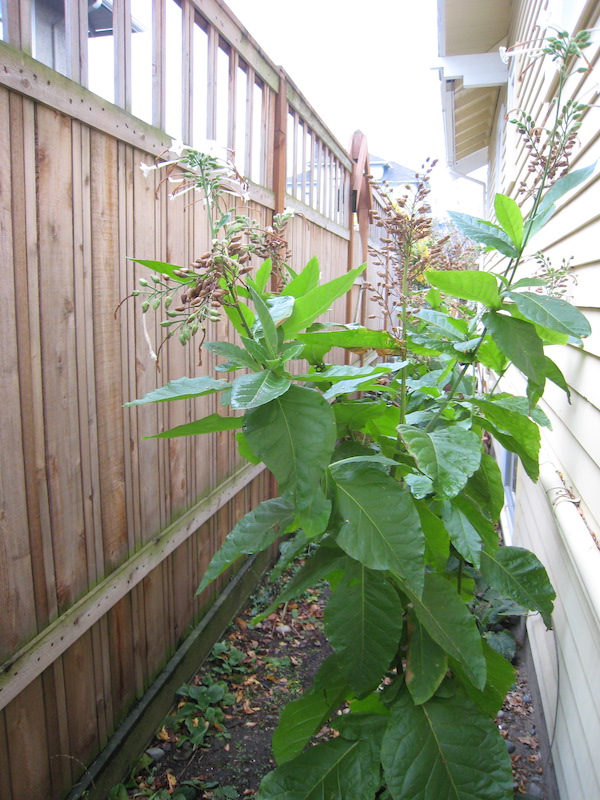
Nicotiana sylvestris ; photo by by ALJ
|
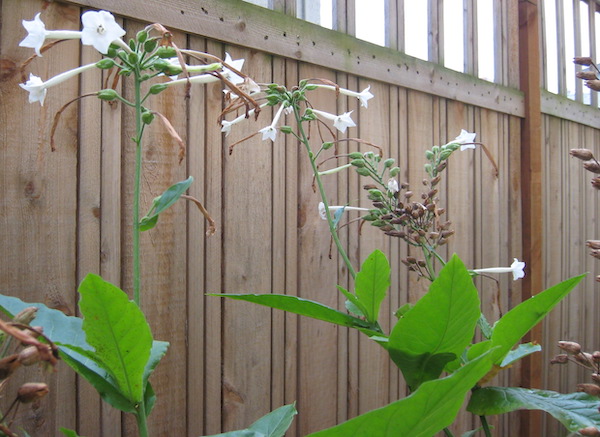
Nicotiana sylvestris ; photo by by ALJ
|
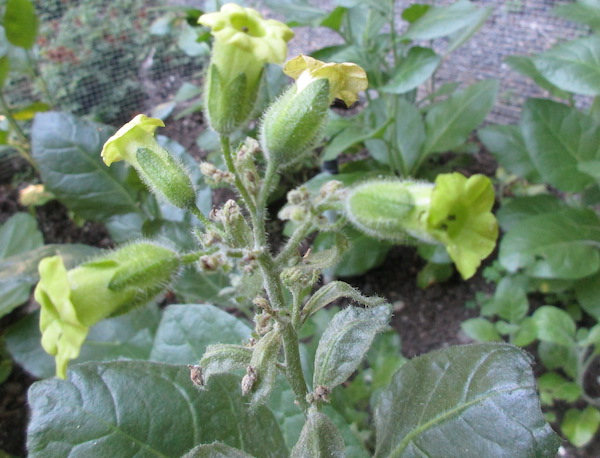
Nicotiana Tabacum ; photo by by ALJ
|
|
|

